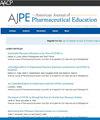To Stay or To Go? Debate Regarding US News and World Report Pharmacy Program Rankings
IF 3.5
4区 教育学
Q1 EDUCATION, SCIENTIFIC DISCIPLINES
引用次数: 0
Abstract
Objective
The methodology used to generate the US News and World Report rankings has been increasingly scrutinized by members of the Academy. The primary objective was to describe the potential positive and negative effects of the Academy ceasing participation in the US News and World Report ranking system (USNWR-RS).
Methods
As part of the Academic Leadership Fellows Program, fellows participated in a debate on current topics in academic pharmacy. For this topic, authors partnered with health science librarians and individually searched the peer-reviewed literature and lay press for evidence related to the USNWR-RS for pharmacy. Each piece of evidence was reviewed by 2 different authors for inclusion, and discrepancies were resolved through discussion. All evidence was then summarized to identify themes related to the primary objective.
Results
Thirteen pieces of evidence were included in the summary: 8 (62%) were from peer-reviewed literature and the remaining were from popular media or news sources. Just over one-third of the pieces of evidence were initially structured as research studies rather than opinion-based articles.
Conclusion
The USNWR-RS has flaws and benefits that should be considered as the Academy works to address concerns. Established work and initial steps toward change lay an encouraging framework for the future.
去还是留?关于《美国新闻与世界报道》药学专业排名的辩论。
目的:用于生成《美国新闻与世界报道》(USNWR)排名的方法越来越受到学院成员的审查。主要目的是描述学院停止参与USNWR排名系统(USNWR- rs)的潜在积极和消极影响。方法:作为学术领导研究员计划(ALFP)的一部分,研究员参加了关于学术药学当前主题的辩论。为了这个主题,作者与健康科学图书管理员合作,单独搜索了同行评审的文献和与usnwrr - rs有关的药学证据。每一项证据都由两位不同的作者审阅,并通过讨论纠正差异。然后总结所有证据,以确定与主要目标有关的主题。结果:总结中包含13条证据:8条(62%)来自同行评议文献,其余来自大众媒体或新闻来源。刚超过三分之一的证据最初是以研究而不是基于观点的文章的形式构成的。结论:USNWR-RS有缺陷也有好处,在学院努力解决问题的过程中应该加以考虑。既定的工作和朝着变革迈出的初步步骤为未来奠定了令人鼓舞的框架。
本文章由计算机程序翻译,如有差异,请以英文原文为准。
求助全文
约1分钟内获得全文
求助全文
来源期刊
CiteScore
4.30
自引率
15.20%
发文量
114
期刊介绍:
The Journal accepts unsolicited manuscripts that have not been published and are not under consideration for publication elsewhere. The Journal only considers material related to pharmaceutical education for publication. Authors must prepare manuscripts to conform to the Journal style (Author Instructions). All manuscripts are subject to peer review and approval by the editor prior to acceptance for publication. Reviewers are assigned by the editor with the advice of the editorial board as needed. Manuscripts are submitted and processed online (Submit a Manuscript) using Editorial Manager, an online manuscript tracking system that facilitates communication between the editorial office, editor, associate editors, reviewers, and authors.
After a manuscript is accepted, it is scheduled for publication in an upcoming issue of the Journal. All manuscripts are formatted and copyedited, and returned to the author for review and approval of the changes. Approximately 2 weeks prior to publication, the author receives an electronic proof of the article for final review and approval. Authors are not assessed page charges for publication.

 求助内容:
求助内容: 应助结果提醒方式:
应助结果提醒方式:


